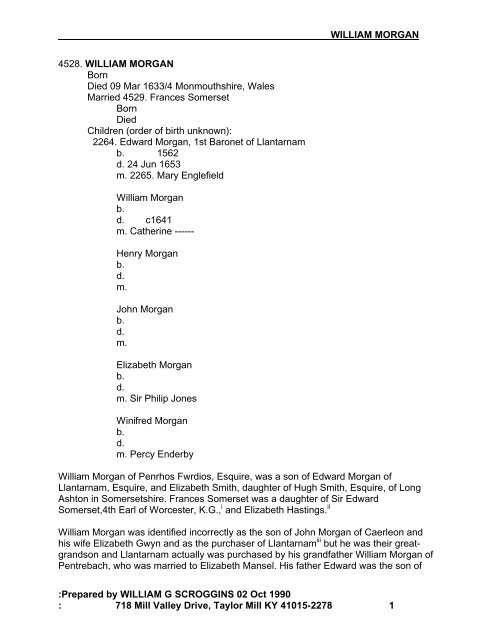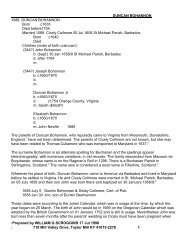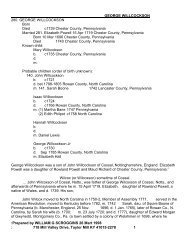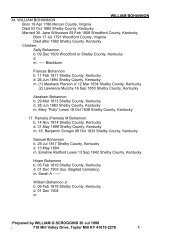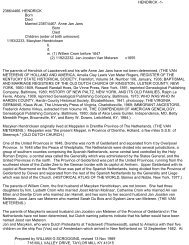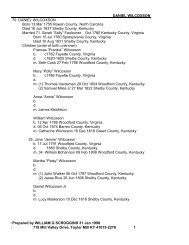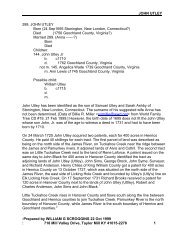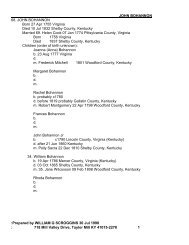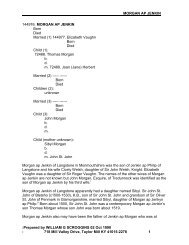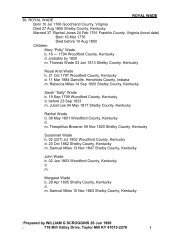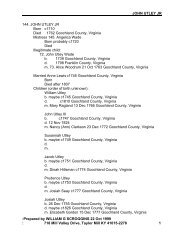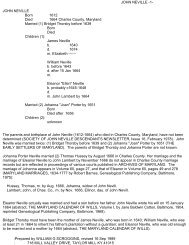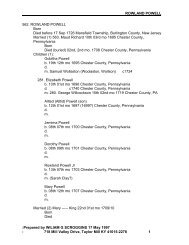WILLIAM MORGAN - Genealogy Research Papers
WILLIAM MORGAN - Genealogy Research Papers
WILLIAM MORGAN - Genealogy Research Papers
You also want an ePaper? Increase the reach of your titles
YUMPU automatically turns print PDFs into web optimized ePapers that Google loves.
<strong>WILLIAM</strong> <strong>MORGAN</strong>4528. <strong>WILLIAM</strong> <strong>MORGAN</strong>BornDied 09 Mar 1633/4 Monmouthshire, WalesMarried 4529. Frances SomersetBornDiedChildren (order of birth unknown):2264. Edward Morgan, 1st Baronet of Llantarnamb. 1562d. 24 Jun 1653m. 2265. Mary EnglefieldWilliam Morganb.d. c1641m. Catherine ------Henry Morganb.d.m.John Morganb.d.m.Elizabeth Morganb.d.m. Sir Philip JonesWinifred Morganb.d.m. Percy EnderbyWilliam Morgan of Penrhos Fwrdios, Esquire, was a son of Edward Morgan ofLlantarnam, Esquire, and Elizabeth Smith, daughter of Hugh Smith, Esquire, of LongAshton in Somersetshire. Frances Somerset was a daughter of Sir EdwardSomerset,4th Earl of Worcester, K.G., i and Elizabeth Hastings. iiWilliam Morgan was identified incorrectly as the son of John Morgan of Caerleon andhis wife Elizabeth Gwyn and as the purchaser of Llantarnam iii but he was their greatgrandsonand Llantarnam actually was purchased by his grandfather William Morgan ofPentrebach, who was married to Elizabeth Mansel. His father Edward was the son of:Prepared by <strong>WILLIAM</strong> G SCROGGINS 02 Oct 1990: 718 Mill Valley Drive, Taylor Mill KY 41015-2278 1
<strong>WILLIAM</strong> <strong>MORGAN</strong>William Morgan and Elizabeth Mansel. His grandfather William was a son of JohnMorgan of Caerleon and Elizabeth Gwyn. iv John Morgan of Caerleon descended fromMorgan ap Llewellyn, lord of St. Clere and Tredegar, who was a descendant of CadivorFawr, lord of Kilsaint. vSir Edward Somerset descended from King Edward III of England and his queenPhilippa of Hainault through their son John Plantagenet of Gaunt, Duke of Lancasterand King of Castile and Leon, and his mistress and eventual third wife Katherine RouetSwinford whose son John Beaufort, 1st Earl of Somerset, married Margaret Holland.Their son Edmund Beaufort, 4th Earl of Somerset, married Eleanor Beauchamp andhad Henry Beaufort, 2nd Duke of Somerset. By his mistress Joan Hill, Duke Henry hada son Sir Charles Somerset, K.G., who was created the first Earl of Worcester in 1514.Charles Somerset married Elizabeth Herbert, only daughter and heir of William Herbert,Earl of Huntingdon, and his wife Mary Wydeville. Their son Henry Somerset, 2nd Earl ofWorcester, Lord Herbert, married(1) Margaret Courtenay and (2) Elizabeth Browne,daughter of Sir Anthony Brown and Lucy Neville. By his second wife he had WilliamSomerset, 3rd Earl of Worcester, K.G., who married (1) Christian North, first daughter ofEdward North,1st Lord North, by his first wife Alicia Squire, and (2) Theophilia NewtonCradock. By his first wife, William Somerset had Edward Somerset, 4th Earl ofWorcester, K.G., who married Elizabeth Hastings, daughter of Francis Hastings,2ndEarl of Huntingdon, K.G., Lord Hastings, and Catherine Pole. viWilliam and Frances Somerset Morgan were ardent Roman Catholics: vii... William Morgan had won the heart and hand of Lady Frances Somerset,daughter of the Earl of Worcester. She was one of the “fair daughters of Raglan.”Their whole family were converted to the true faith by the saintly Jesuit, FatherJones, and William and Lady Morgan became the founders of the Jesuit Missionin Wales.Soon after her conversion, she (Lady Frances), reflecting that most of herhusband’s Estates consisted of Church Livings, dealt with him about makingsome satisfaction for the same. Both her husband and herself conceived wellthat Missionaries of the Society should be maintained in both parts of Wales tolabour therein. And accordingly the Lady made a Will, her husband assentingand subscribing thereunto, and thereby ordered that two of the Society should bemaintained in North, and two in South Wales for that end and purpose.In a report from the High Sheriff of Herefordshire, to the Privy Council,1605,Father Jones is called “the firebrand of all” and the lay gentlemen who run thiscourse with the Jesuits are ... “Mr. Morgan, the younger, of Llantarnam, withwhom the said Jones, the Jesuit, is very often, sometimes for a month together.”The same report shows that William Morgan was under suspicion as being “busyabout Armour,” about to take a dangerous part in the political affairs of his time in1605, the year of the Gunpowder Plot. As proprietor he did not survive his father:Prepared by <strong>WILLIAM</strong> G SCROGGINS 02 Oct 1990: 718 Mill Valley Drive, Taylor Mill KY 41015-2278 2
<strong>WILLIAM</strong> <strong>MORGAN</strong>by a full year.The statement that “he did not survive his father by a full year” refers to the death ofWilliam Morgan on 09 March 1634 after his father Edward had died on 26March 1633: viiiEdward Morgan of Llantarnam, esq., M.P. co. Mon. 1584-5 and 1586-7; sheriff1582; ob. 26 March 1633/4.William Morgan of Penrhos Fwrdios, esq., ob. 9 March 1633/4; adm’on toEdward the son 1635. Inq. p.m. 21 May 1635.At this time, the Julian calendar was in use wherein the year began on 25 March, sohistorians frequently show March dates as 1633/4 to indicate that it was 1633 on the oldcalendar and 1634 on the current Gregorian calendar wherein the year begins on 01January. In actuality, at the time of Edward Morgan’s death 26 March was the 2nd dayof the 1st month 1633. William Morgan then died, less that 12 months later, on the 09March in the same year, 16 days before the year ended on 24 March. ixThe Gunpowder Plot was engineered by a Catholic named Robert Catesby in 1604 toblow up the King, lords and commons at the opening of Parliament. Both the Catholicsand the Puritans of the time had appealed to King James I for better treatment. Theywere being fined for recusancy, which was the refusal to attend the services of theChurch of England. King James remitted the fines for recusancy but banished theCatholic priests from London. Thereupon Catesby decided to destroy the powers thatdealt with his co-religionists so harshly. He communicated his idea to Guy Fawkes, acool and intrepid soldier in Flanders, who found it acceptable and came to England. Theconspirators placed barrels of gunpowder in a cellar that ran beneath both houses ofParliament with the intention of exploding it during the second session of Parliament on05 November1605. However one of the conspirators became afraid and betrayed theplot. Fawkes was apprehended in the act of setting the fuse to the powder and he andhis companions, who were captured with him, were executed. Afterward the persecutionof the Catholics increased. xThe maiden name of Catherine, wife of William Morgan (Jr.), is not known. They hadtwo children, Joseph who was underage in 1641 and Winifred Morgan. The will ofWilliam Morgan, who lived at Pentrebach, was dated 19 July 1641 and proved on18February 1641/2. xiHenry Morgan also lived at Pentrebach. xiiJohn Morgan, who lived at Trostre, had two sons, William and Edward Morgan. xiiiThe husband of Elizabeth Morgan, Sir Philip Jones, Knight, lived at Treowen. xiv He wasthe eldest son of William Jones of Treowen and Llanarth, Esquire, and his wife Janewho was the only daughter and heir Moor Gwillim of Monmouth, Esquire. Sir Philip wasin Raglan Castle when it was taken and destroyed by Sir Thomas Fairfax. His will wasdated in 1659 and he died the following year. Sir Philip and Elizabeth Morgan had:Prepared by <strong>WILLIAM</strong> G SCROGGINS 02 Oct 1990: 718 Mill Valley Drive, Taylor Mill KY 41015-2278 3
<strong>WILLIAM</strong> <strong>MORGAN</strong>William who married Mary Anderton; Henry who married a Milborne; Edward; Elizabethwho married Hugh Lewis; Winifred who married George Watkins; Mary who married aMilborne; Anne; Frances; Clare; Margery; Jane; and Lucy. xvPercy Enderby who married Winifred Morgan was from Lincolnshire, England. Helearned the Welsh language and wrote Cambria Triumphans. xvi He also wrote a poem in1661 extolling the virtues of the Morgan family. The title was defined as meaning “apersonification of a Morgan patriarch of the acclaimed oldest branch of the family, thatof Tredegar of South Wales,” and several explanatory footnotes accompanied thetranscription: xviiProsopopoeia TredegarYou who by Right enjoy a Morgan’s Name,Know that from Me you do enjoy the same:I am the Root, ye the Branches are,Whose Gallant worth hath spread itself so far,That Ireland in her rebellious Time,Found a stout Morgan(3) to reprove her crime;Not only to reprove, but to beat downThe proud opposers of Eliza’s Crown.The Netherlands, had there no Morgan(4) beenHad lost their bravest Towns, and never seenThe Peace they now enjoy; let them erectThe Choicest Columns that an ArchitectCan frame by Art, they will Atoms beIn the Respect of Morgan’s gallantry.How many this Country(5) glory in my Name?How many Morgans glory in the same?All sprung from Me, Pencoyd, Lantarnam sore,(6)Penhow, St. Pierre, Pentlau, which doth storeThis Shire with many Stems, I reckon notThe ‘mediate Branches by myself begot.Grindy and Pentre-bach,(7) had that not knownA winter’s Frost, might have some Blossoms shown.Old Wernycleppa, and Tredoneck’s Race,Hopkins of Machen here must find a place;Rupera and Rubenny, though it be[Out of the Circle of this Countrie(8)];And so Lan Rumney, yet must bend their knee,And from Tredegar fetch their Pedigree.Wonder not that I do not Machen name,Were not the Lambeaux then the Coates sameWhich learned Heralds know to be a SignThat he’s the Heir apparent of that Line.What families from hence to England went,And there to Knightly Offsprings gave Descent?:Prepared by <strong>WILLIAM</strong> G SCROGGINS 02 Oct 1990: 718 Mill Valley Drive, Taylor Mill KY 41015-2278 4
<strong>WILLIAM</strong> <strong>MORGAN</strong>Morgan of Weston and the Southern LineOf wealthy Morgans, whose great wealth does shineLike Stars; can tell you yet from Me their Sun,Their brightest Light, and Lustre first begun.From Me they issued, first from Me they were,And first took Life, which in my HemisphereOf lesser Rank, what numerous Branches be;’Twould trouble even the deepest HeraldryTo find Distinctions, how to SubdivideThe treble younger by the Father’s Side.Who was himself, when first his House begun,But third or second to a younger Son.Thus hath the Highest blest me, blest be He,The Author of All Offsprings through Eternity,Amen(3) Sir William Morgan, Knight, of Pencoed. Sir William, in the year 1579, wrotefrom the Court to Sir Edward Stradling: Whereas I ame appointed by theQueene and the Councell furthewith to go in to Ireland with the men owtof South Wales, which I doubt and feare I shall finde exceedinge rawe, yetmy trust and hope is in you that you wil be careful to helpe me to suchemen as shal be able of bodie, whereby the Queene may the better be servid,and I therebie may get fame honestlie ... prauinge yow ... that theircottes[coats] may be reed, with a little alce of grene ... and that they mayhave some allowance of some convenient store of powder for to trainetheir shotte while they are of this side the sea, and on the sea in goinge ...(4) Several cadets of the family followed the wars in the Low Countries, andappear prominently and valiantly in the history of that warfare; notably SirThomas Morgan, Knight, who formed the regiment since known as the“Buffs,” and was governor of Bergen-op-Zoom in the year 1594; SirMathew Morgan, Knight, and General Sir Charles Morgan, Knight, whosucceeded in command of the “Buffs,” and especially distinguished himselfin the siege of Bergen-op-Zoom, in the year 1621.(5) i.e, County.(6) “Sore,” unidentified as a locality; was perhaps, used adjectively withLlantarnam, to denote a lingering tenderness there after recent extortionsby government seizure of estates, etc., and by the imprisonment of SirEdward Morgan, of Llantarnam.(7) Pentre-bach within the parish of Llantarnam, formerly a Morgan residence.The appearance of (3) as the first footnote and the absence of the footnote denoted (8)in the poem, suggests that this transcription was lifted from another context verbatimand published without editing. Sir William Morgan of Pencoed, who was to lead troopsto Ireland in 1579, must have been related to William Morgan of Penrhos Fwrdios,Esquire, who purchased Llantarnam and died in 1582, through his great-greatgrandfatherSir Thomas Morgan of Pencoed whose son Sir John Morgan was described:Prepared by <strong>WILLIAM</strong> G SCROGGINS 02 Oct 1990: 718 Mill Valley Drive, Taylor Mill KY 41015-2278 5
<strong>WILLIAM</strong> <strong>MORGAN</strong>as of Caerleon where he was keeper of the royal park. xviiiFootnote 6 could have been more positive in interpreting the word sore as a poeticapplication, describing Llantarnam as filled with sadness, grief or sorrow; distressed; asin a sore hardship. In archaic usage, sore meant sorely and an obsolete definition is towound; to make sore. Heartsore is an adjective meaning feeling or showing grief;grieved.Elizabeth Stradling, daughter of Sir Edward Stradling, married John Morgan, son ofJohn Morgan and Letitia (Lettice) Herbert, daughter of Sir George Herbert of St. Julians,and grandson of Sir Morgan John and Margaret Morgan, daughter of Thomas Morganof Pencoed. John Morgan and Elizabeth Stradling were the parents of Miles Morgan, anadventurer who died in 1581 on a voyage to America with Sir HumphreyGilbert. xixThe description of Lady Frances Somerset as one of the “fair daughters of Raglan,”refers to Raglan Castle, which is about 15 miles from Newport in Gwent (formerlyMonmouthshire) near the intersection of Route 40 from Abergavenny and Route 449from Newport to the town of Monmouth. xx Edward and Frances Hastings Somerset wereburied at Raglan Castle. xxiIt is likely that the so-called conversion of William and Frances Somerset Morganactually was an mistaken interpretation of their decision to actively support the Jesuits.Their fathers were active Catholics, with William’s father being fined for recusancy in1605 xxii and Frances’ father was a Papist who, ironically, served as a commissioner forthe expulsion of Jesuits from Wales in 1602/3. xxiiiNOTESi . A History of Monmouthshire From the Coming of the Normans into Wales Down tothe Present Time, Joseph Alfred Bradney, C.B., M.A., F.S.A., Volume III, Part 2,comprising 16 parishes and hamlets in the Hundred of Usk, includingLlanfihangel Llantarnam, Mitchell, Hughes and Clarke, London, 1923.ii . A Genealogical and Heraldic History of the Extinct and Dormant Baronetcies ofEngland, Ireland and Scotland, John Burke, Esq., and John Bernard Burke, Esq.,London, 1841, reprinted Genealogical Publishing Company, Baltimore, 1977.iii . A History of the Family of Morgan, James Appleton Morgan, privately, New York,c1902.iv . Supra notes 1 and 2.v . Supra note 3.vi . The Kings and Queens of Great Britain, a chart, Anne Taute, Elm Tree Books,London, 1976; A Genealogical History of the Dormant, Abeyant, Forfeited, andExtinct Peerages of the British Empire, Sir Bernard Burke, C.B.,LL.D., London,1883, reprinted Genealogical Publishing Company, Baltimore, 1978; TheComplete Peerage, George E. Cokayne, London, 1910-1959.vii . Photocopy, Llantarnam Abbey Through the Ages, pages 8-17, monograph,:Prepared by <strong>WILLIAM</strong> G SCROGGINS 02 Oct 1990: 718 Mill Valley Drive, Taylor Mill KY 41015-2278 6
<strong>WILLIAM</strong> <strong>MORGAN</strong>unidentified author, Sisters of St. Joseph of Annecy, Llantarnam Abbey, c1978.viii . Supra note 1.ix . Julian to Gregorian, John W. Heisey, article in Antique Week/Tri-State Trader,<strong>Genealogy</strong> Section, Knightstown, IN, 1986.x . Lincoln Library of Essential Information, Volume 1, 13th Edition, The FrontierPress, Buffalo, 1967.xi . Supra note 1.xii . ibid.xiii . ibid.xiv . ibid.xv . A Genealogical and Heraldic History of the Commoners of Great Britain andIreland, John Burke, Esq., Volume IV, London 1834-38, reprinted GenealogicalPublishing Company, Baltimore, 1977.xvi . ibid.xvii . Morgan the Family, American Genealogical <strong>Research</strong> Institute,1975.xviii . ibid.xix . ibid.xx . Royal Auto Club map.xxi . The Complete Peerage, George E. Cokayne, London, 1910-1959.xxii . Supra note 7.xxiii . Supra note 20.:Prepared by <strong>WILLIAM</strong> G SCROGGINS 02 Oct 1990: 718 Mill Valley Drive, Taylor Mill KY 41015-2278 7


